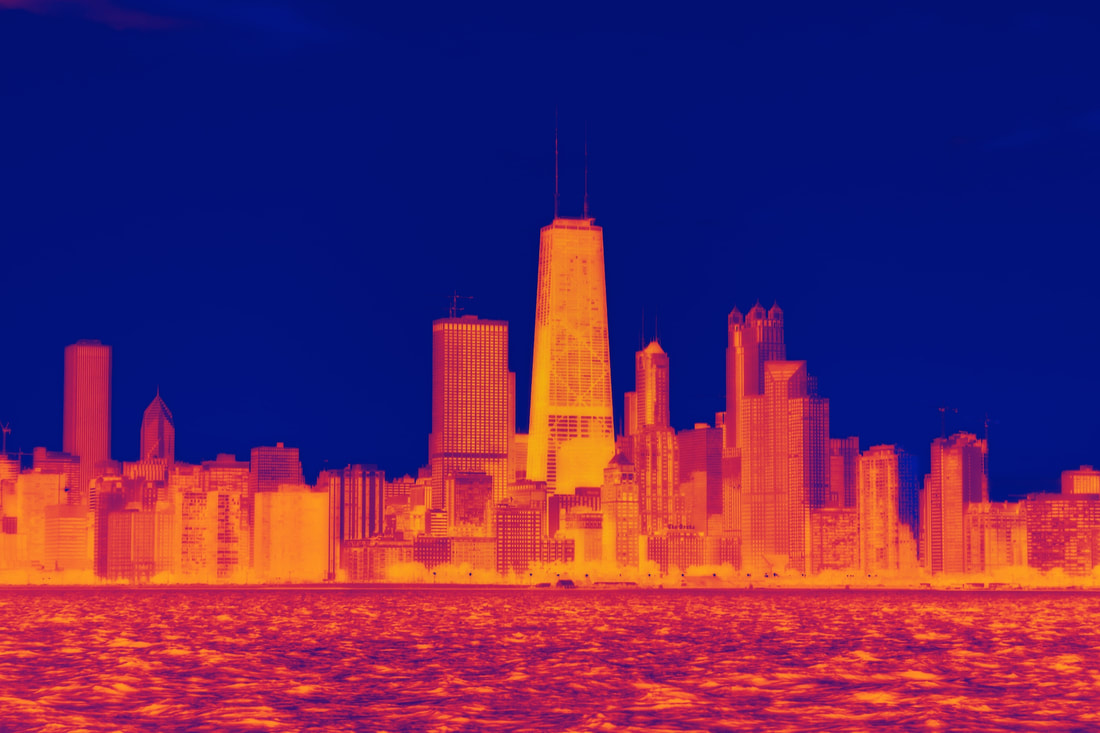Blog |
Discussing current issues in engineering
|
 Photo credit: Dustin Phillips, CC BY-NC-ND 2.0 As summer enters full swing throughout the United States—bringing with it record-setting heat waves, threats of power outage, and cases of heat-related illness—scientists, engineers, and urban planners are considering urban surface alternatives that might reduce the effects of heat pollution in cities.
Many cities around the world record average temperatures between 2 and 4°C warmer than neighboring rural areas. This phenomenon, known as the Urban Heat Island effect, occurs because typical urban surfaces (like pavement) absorb more heat than natural surfaces (like grass) which often characterize rural regions. For the individuals who live in urban centers, stakes are high (and climbing higher). From 2004 to 2018, the Centers for Disease Control and Prevention (CDC) recorded an annual average of 702 heat-related deaths in the United States. As global warming increases the likelihood of extreme weather events like heat waves, the need for effective remediation against heat pollution grows. Otherwise, we could see cities throughout the world become unlivable for part or all of the year. In a paper recently published by the journal Nature Communications, researchers from the University of Pittsburgh’s Swanson School of Engineering model the effects of reflective surface applications on conventional urban surfaces in a neighborhood. Coauthors Sushobhan Sen and Lev Khazanovich used Computational Fluid Dynamics to model air currents in a prototypical neighborhood as it was subjected to alternate spatial distributions of reflective surfaces. Their research yields promising insights that can be used to address urban heat pollution. The team found that widespread application of reflective surfaces reduced air temperatures throughout the simulated neighborhood by up to 1.9°C, but this came with a significant investment. Alternate models revealed that temperature reductions as great as 1.1°C could be generated by adding reflective materials to 50% of existing surfaces, rather than 100%. In cases where researchers located reflective surfaces upstream from conventional surfaces, cooler air currents penetrated the downstream homes in addition to upstream homes. Because reflective surfaces are cooler than conventional surfaces, dominant wind cools as it passes through high reflectance areas and continues to travel downstream, cooling the rest of the city at a reduced cost. Sen notes that strategic placement of reflective surfaces is key. The effectiveness of high reflectance surfaces declines when they are placed downstream of or parallel to the dominant wind direction—less mixing of air restricts cooling to the part of the neighborhood with reflective surfaces. In order to maximize the effectiveness of minimal resources, engineers and urban developers must evaluate both spatial distribution of reflective surfaces and dominant wind streams throughout neighborhoods. In doing so, they enable a substantial decline in city temperatures with half the material investment required of total surface application. Click here to read Sen and Khazanovich’s work in the journal, Nature Communications. To learn more about heat-related deaths in the United States, click here.  Photo credit: Ken Kistler, CC0 1.0 Concrete has dominated the modern construction industry since the start of its commercial manufacturing in the nineteenth century. Asphalt concrete, a specific variety of concrete used for paving and typically referred to as “asphalt,” gained popularity during this same period. As the foremost option for road construction, asphalt’s popularity rose in conjunction with the commercial automobile industry. Today, concrete is the most commonly used building material in the world, and second only to water as the world’s most widely used substance.
Despite worldwide popularity, concrete and asphalt structures can fall short of their expected lifespans. Modern concrete and asphalt structures are known to deteriorate far faster than their historical counterparts. Deterioration takes many forms: cracks, breakdown into fine particles, interior hollowing, and separation into layers. All forms of deterioration threaten the integrity and safety of structures, translating into decreased lifespans and increased maintenance or replacement costs. When compared to the endurance of historical concrete, widely studied processes like aggregate expansion, chemical damage, and rebar corrosion (in reinforced structures) present only a partial picture of deterioration root causes for modern concrete structures and asphalt pavements. A paper recently published by the journal PLOS ONE sheds light on one significant additional cause of deterioration. The paper authors—a team of researchers drawn from six diverse institutional environments (medicine, manufacturing, higher education, and consulting)—began their inquiries with the unexplained odor that emanates from commercial cement when mixed with water. The researchers hypothesized that the odor derived from organic matter. From there, they examined the presence of organic matter in relation to concrete deterioration. Currently, scientists and inspectors determine deterioration rates through surface crack measurements and a chemical test. This team of researchers used a micro focus CT scanner, like those used in medical settings, to develop cross-sectional images of asphalt and concrete samples. The samples originated from a variety of geographical locations and time periods where unexplained asphalt and concrete damage had occurred. After procurement, researchers exposed the samples to test conditions reproduced from moisture permeation levels calculated in the field. This permeation process enabled the team to accurately represent the real-world relative humidity of summer. Researchers determined that asphalt and concrete samples contained organic molecules from a variety of sources: phthalates, surfactants, windshield washer fluids, and diesel exhaust particulates. Comparisons between CT scans showed that phthalates, chemicals used to increase the durability of plastics, had the most significant effect on concrete and asphalt deterioration. For the first time, researchers demonstrated that organic matter levels, whether introduced during the production process or real-world exposure, were indicators for the deterioration present in modern concrete and asphalt. The researchers believe that their findings will contribute to the development of enduring concrete and asphalt materials and structures. To read more about the study and findings, click here. |
Colman Engineering, PLCA professional engineering firm located in Harrisonburg, VA Archives
January 2022
|

 RSS Feed
RSS Feed
